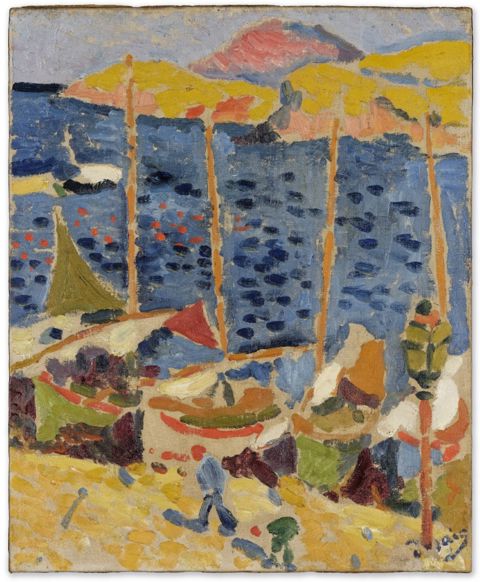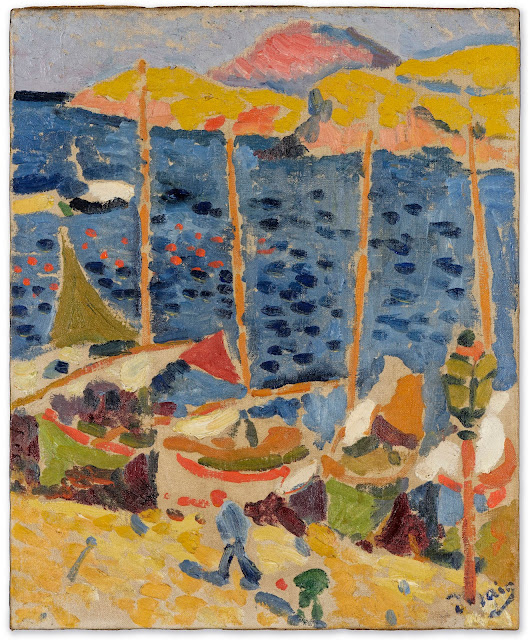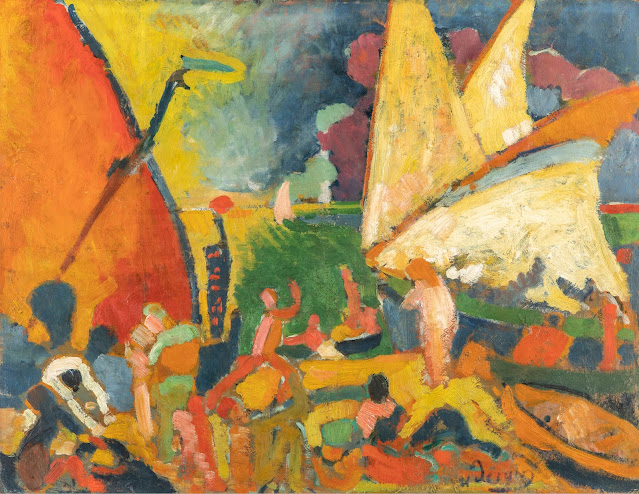Museum of Fine Arts, HoustonOpens February 25, 2024
—Over nine intense weeks in the summer of 1905, Henri Matisse (1869–1954) and André Derain (1880–1954) embarked on a creative partnership that would change the course of French painting. Through an audacious exploration of new aesthetic territory, the two painters experimented with daring directions in paint and energetic bursts of color, form, and structure that immediately resulted in a boldly inventive artistic language known as Fauvism (from the French fauve, or “wild beast”).
On view at the MFAH from February 25 to May 27, 2024, following its debut at the Metropolitan Museum of Art, New York, Vertigo of Color: Matisse, Derain, and the Origins of Fauvism presents, for the first time in the United States, the legacy of that legendary summer through 65 of Matisse’s and Derain’s paintings, drawings, and watercolors on loan from national and international museums and private collections.
Commented Gary Tinterow, Director and Margaret Alkek Williams Chair, Museum of Fine Arts, Houston, “The work that Matisse and Derain created over the summer they spent experimenting together, in 1905, liberated color from its traditional, representational role. This innovation freed them, and the artists who followed, to use color as color, radically changing modernist painting. Vertigo of Color tells this story through an unprecedented selection of loans from a host of public and private collections. We are very pleased to partner with the Metropolitan Museum in bringing this revelatory exhibition to Houston.”
It was the partnership between the two artists—and their intense investigations of color and light, along with their will to experiment outside the canon—that led to Fauvism in the early years of the last century. While staying in the modest fishing village of Collioure, Matisse and Derain drew from local surroundings as they experienced the bustling life of the port, the quiet beaches, and surrounding landscapes. A new aesthetic of color and light was in process. Their evolving visual language grew from sensory experience of a moment in time, a sweep of sand brushed in saturated red, a cork oak tree delineated in pink, shadows of reflected light in dazzling hues. Matisse wrote, “My choice of colors does not rest on any scientific theory; it is based on observation, on feeling, on the experience of my sensibility.”
Exhibiting several paintings at the Salon d’Automne in Paris in November 1905, Matisse and Derain were derided and praised. They puzzled audiences, stirred controversy, and soon galvanized a group of contemporary artists to follow in their path—a new path in European art that radically contradicted conventional norms. Responding to the now-legendary Salon exhibition, a prominent French journalist labeled them “les Fauves,” literally “wild beasts.” A ravishing palette was at play in an evolving modernist dialogue, canvas colors later referred to as Fauvist.
Vertigo of Color: Matisse, Derain, and the Origins of Fauvism will feature many of the most celebrated works of Fauvism. Several of the paintings haven’t been shown in the United States in half a century, including Derain’s portrait of Matisse, Henri Matisse (Tate); Matisse’s portrait of Derain, André Derain (Tate); and Woman with a Shawl: Madame Matisse in a Kimono (private collection). The works on view will be on loan from museums including Musée National d’Art Moderne, Centre Pompidou; National Galleries of Scotland; National Gallery of Art, Washington, D.C.; San Francisco Museum of Modern Art; and the Museum of Modern Art, New York; as well as private collections.
The exhibition also explores a personal story. Matisse arrived first in Collioure with his wife Amélie and two sons, and later urged the younger Derain to join him for a few weeks to sketch and paint along the beaches and forests in the foothills of the Pyrénées. While the exhibition foregrounds the marvelous partnership of the two artists, it also traces their divergent paths on canvas and paper: Derain was determined to finish his canvases in Collioure, while Matisse thought otherwise, choosing instead to gather inspiration and source material for his Paris studio. Vertigo of Color will include several of Matisse’s pen and ink sketches and watercolors. It will demonstrate Matisse’s immense influence on modernism in the early years of the 20th century.
Vertigo of Color: Matisse, Derain, and the Origins of Fauvism is curated at The Met by Dita Amory, Robert Lehman Curator in Charge, Robert Lehman Collection, and at the Museum of Fine Arts, Houston, by Ann Dumas, Consulting Curator of European Art.
Catalogue
A fully illustrated catalogue will accompany the exhibition. Published by The Metropolitan Museum of Art and distributed by Yale University Press, it is available for purchase from The Met Store. Authors include curators Dita Amory and Ann Dumas; Met conservator Isabel Duvernois; and Isabelle Monod-Fontaine, Curator Emerita, Centre Pompidou, Paris.
In the summer of 1905, the French painters Henri Matisse and André Derain changed the course of art history with their radical color experiments
During the summer of 1905, Henri Matisse and André Derain went on holiday in Collioure, a modest French fishing village fifteen miles from the Spanish border. This groundbreaking book examines how two artists, entranced by the shifting light and stunning imagery of the eastern Mediterranean, laid the groundwork for the movement known as Fauvism (from the French fauve, or “wild beast”). Featuring more than 70 paintings, watercolors, and drawings produced by Matisse and Derain during their stay, the book also brings to life their personal and artistic revelations with 21 of their letters, published here for the first time in English. Vivid and engaging texts detail their daring experiments with color, form, structure, and perspective; the scandal their paintings caused when they were exhibited several months later; and how, despite the jeering remarks from critics, these works changed the course of French painting. Emphasizing as never before the legacy of that summer, this publication shows how the two artists’ radical investigations galvanized their contemporaries, and how this strain of modernism, created almost by accident, resonates even into the present day.
Published by The Metropolitan Museum of Art/Distributed by Yale University Press
IMAGES
Henri Matisse, Open Window, Collioure, 1905, oil on canvas, National Gallery of Art, Washington, collection of Mr. and Mrs. John Hay Whitney. © 2023 Succession H. Matisse / Artists Rights Society (ARS), New York | |
André Derain, Boats at the Port of Collioure, 1905, oil on canvas, private collection. © 2023 Artists Rights Society (ARS), New York / ADAGP, Paris | |
André Derain, The Port of Collioure, 1905, oil on canvas, Albertina Museum, Vienna. © 2023 Artists Rights Society (ARS) New York / ADAGP, Paris |
André Derain, The Pier at L’Estaque, 1906, oil on canvas, private collection, photograph courtesy of David Levy & Associés, Brussels. © 2023 Artists Rights Society (ARS), New York, ADAGP, Paris | |
Henri Matisse, Landscape at Collioure (Study for “The Joy of Life”), 1905, oil on canvas, Statens Museum for Kunst, Copenhagen. © 2023 Succession H. Matisse / Artists Rights Society (ARS), New York | |
André Derain, The Faubourg of Collioure, 1905, oil on canvas, Musée d’Art Moderne, Centre Pompidou, Paris. © 2023 Artists Rights Society (ARS), New York / ADAGP, Paris | |
André Derain, The Sailboats at Collioure, 1905, oil on canvas, National Museum, Serbia. © 2023 Artists Rights Society (ARS), New York / ADAGP, Paris |
André Derain, The Port at Collioure, 1905, oil on canvas, private collection, courtesy Stoppenbach & Delestre. © 2023 Artists Rights Society (ARS), New York / ADAGP, Paris | |
André Derain, Woman with a Shawl, Madame Matisse in a Kimono, 1905, oil on canvas, private collection, courtesy of Nevill Keating Pictures, London. © 2023 Artists Rights Society (ARS), New York / ADAGP, Paris | |
Henri Matisse, André Derain, 1905, oil on canvas, Tate, purchased with assistance from the Knapping Fund, the Art Fund, and the Contemporary Art Society, and private subscribers, 1954. © 2023 Succession H. Matisse / Artists Rights Society (ARS), New York |
André Derain, Henri Matisse, 1905, oil on canvas, Tate, purchased 1958. © 2023 Artists Rights Society (ARS), New York / ADAGP, Paris | |
André Derain, Fishing Boats, Collioure, 1905, oil on canvas, the Metropolitan Museum of Art, New York, gift of Raymonde Paul, in memory of her brother, C. Michael Paul, and purchase, Lila Acheson Wallace Gift, 1982. © 2023 Artists Rights Society (ARS), New York / ADAGP, Paris |





,%201905.jpg)










